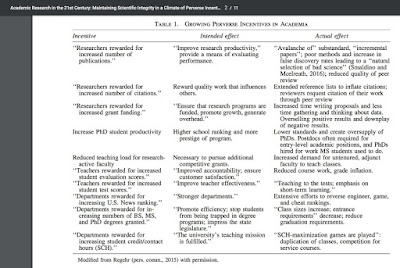Perverse incentives in academia

According to Wikipedia, " A perverse incentive is an incentive that has an unintended and undesirable result which is contrary to the interests of the incentive makers. Perverse incentives are a type of negative unintended consequence ." There is an excellent (but depressing) article Academic Research in the 21st Century: Maintaining Scientific Integrity in a Climate of Perverse Incentives and Hypercompetition Edwards Marc A. and Roy Siddhartha I learnt of the article via a blog post summarising it, Every attempt to manage academia makes it worse. Incidentally, Edwards is a water quality expert who was influential in exposing the Flint Water crisis. The article is particularly helpful because it cites a lot of literature concerning the problems. It contains the following provocative table. I also like the emphasis on ethical behaviour and altruism. It is easy to feel helpless. However, the least action you can take is to stop looking at metrics when reviewing






